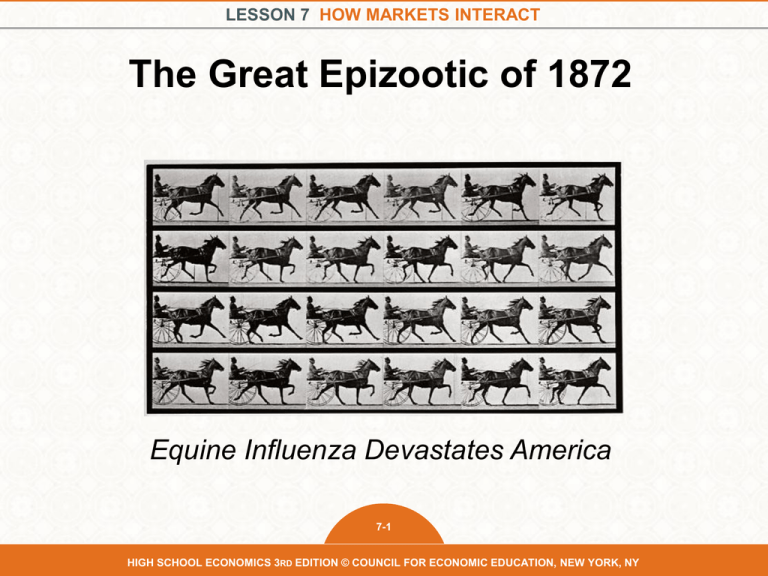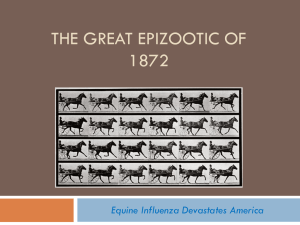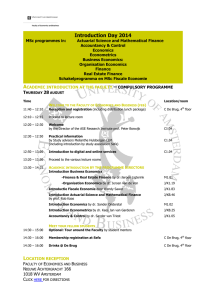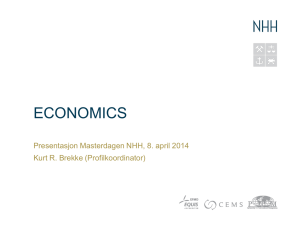The great epizootic of 1872 - High School Economics
advertisement

LESSON 7 HOW MARKETS INTERACT The Great Epizootic of 1872 Equine Influenza Devastates America 7-1 HIGH SCHOOL ECONOMICS 3RD EDITION © COUNCIL FOR ECONOMIC EDUCATION, NEW YORK, NY LESSON 7 HOW MARKETS INTERACT America Comes to a Halt We see these forms of transportation every day and seldom stop to think of the integral role they play. What if our “workhorses” were suddenly unavailable? 7-2 HIGH SCHOOL ECONOMICS 3RD EDITION © COUNCIL FOR ECONOMIC EDUCATION, NEW YORK, NY LESSON 7 HOW MARKETS INTERACT America Ran on Horse Power Throughout most of U.S. history, the horse was the engine of business and commerce. Our nation relied on that gentle animal to move freight and perform countless tasks. 7-3 HIGH SCHOOL ECONOMICS 3RD EDITION © COUNCIL FOR ECONOMIC EDUCATION, NEW YORK, NY LESSON 7 HOW MARKETS INTERACT Horses per Square Mile New Orleans Atlanta Washington Baltimore Philadelphia New York Buffalo Albany Boston Kansas City Milwaukee Cincinnati Detroit Chicago 0 200 400 600 7-4 HIGH SCHOOL ECONOMICS 3RD EDITION © COUNCIL FOR ECONOMIC EDUCATION, NEW YORK, NY 800 LESSON 7 HOW MARKETS INTERACT 09/25 10/01 10/10 10/14 10/17 10/18 10/19 10/21 10/22 10/22 10/23 10/23 10/24 10/26 10/28 10/28 10/29 11/01 11/02 11/04 11/05 11/06 11/10 11/10 11/13 11/27 12/01 12/07 01/26 Markham, Ontario Toronto, Ontario Detroit, MI Buffalo, NY Rochester, NY Montreal, Quebec Syracuse, NY Keene, NH New York, NY Boston, MA Bangor, ME Chicago, IL Baltimore, MD Pontiac, MI Philadelphia, PA Washington, DC Columbus, OH Newark, DE Charleston, SC Springfield, IL Grand Rapids, MI Richmond, VA Indianapolis, IN Savannah, GA Louisville, KY New Orleans, LA Colorado Springs, CO Havana, Cuba Albuquerque, NM A highly contagious strain of equine influenza originated in Toronto, Canada, and swept south into the United States in late 1872, affecting the entire country within 90 days. Records show that 80–99 percent of all horses were eventually infected— unable to stand in their stables and coughing violently in the streets. 7-5 HIGH SCHOOL ECONOMICS 3RD EDITION © COUNCIL FOR ECONOMIC EDUCATION, NEW YORK, NY LESSON 7 HOW MARKETS INTERACT America Came to a Standstill The government in Washington, D.C., was shut down. Ships in New York harbor could not unload their cargo. A small fire in Boston grew into a devastating inferno, destroying a large amount of the city. The U.S. Cavalry was forced to fight the Apaches on foot. 7-6 HIGH SCHOOL ECONOMICS 3RD EDITION © COUNCIL FOR ECONOMIC EDUCATION, NEW YORK, NY LESSON 7 HOW MARKETS INTERACT Everyday Life Was Frozen In Philadelphia: Streetcars were idled. Freight remained at wharves and railroad depots. Supplies of milk, ice, and groceries disappeared quickly. Saloons no longer offered beer. Work halted at construction sites without lumber and brick deliveries. Fires burned unattended and garbage piled up on the curb. 7-7 HIGH SCHOOL ECONOMICS 3RD EDITION © COUNCIL FOR ECONOMIC EDUCATION, NEW YORK, NY LESSON 7 HOW MARKETS INTERACT Isolating the Sick Was Ineffective While the mortality rate was relatively low, estimated at about 2 percent overall, large cities lost many more horses than rural areas. Because there were no horses to haul coal out of mines, railroads and thousands of other businesses went bankrupt. A four-story horse hotel was used to quarantine the animals, to no avail. Philadelphia lost 2,500 horses. Of the 600,000 horses in the state of New York, more than 90 percent fell ill. 7-8 HIGH SCHOOL ECONOMICS 3RD EDITION © COUNCIL FOR ECONOMIC EDUCATION, NEW YORK, NY LESSON 7 HOW MARKETS INTERACT Newspapers Report Desperation A New York Times article, October 24, 1872, gives a glimpse of the extent of the outbreak: “There is hardly a public stable in the city which is not affected.” “It is not uncommon along the streets of the city to see horses dragging along with drooping heads and at intervals coughing violently.” “Large quantities of freight are accumulating along the Erie Railway in Paterson, New Jersey.” “The disease is spreading rapidly in Bangor, Maine. All fire department horses in Providence, Rhode Island, are sick.” 7-9 HIGH SCHOOL ECONOMICS 3RD EDITION © COUNCIL FOR ECONOMIC EDUCATION, NEW YORK, NY LESSON 7 HOW MARKETS INTERACT The Fate of the Economy Was in Jeopardy It was becoming apparent that a nation so heavily dependent on the horse for so much could suffer an economic calamity from this epidemic. Remember, this disease began spreading in the fall of 1872. What are most farmers doing in the fall of every year? How do midwestern crops get to eastern cities? What impact would this event have had on people’s ability to buy food for their families? 7-10 HIGH SCHOOL ECONOMICS 3RD EDITION © COUNCIL FOR ECONOMIC EDUCATION, NEW YORK, NY LESSON 7 HOW MARKETS INTERACT Great Boston Fire of 1872 Consumes Horseless Industrial Area The story of this fire is still recounted in Boston, but few realize the blaze’s magnitude was a consequence of the Great Epizootic. On November 9, fire swept quickly through the industrial section of the city, ultimately killing 20 people and destroying 65 acres on which 776 buildings burned. 7-11 HIGH SCHOOL ECONOMICS 3RD EDITION © COUNCIL FOR ECONOMIC EDUCATION, NEW YORK, NY LESSON 7 HOW MARKETS INTERACT Firemen Strapped Harnesses to Themselves to Haul Water No one is certain how the fire started. The water supply was inadequate, and many buildings had wooden roofs and were filled with flammable materials. Citizens of Boston were forced to haul water to the location on foot, without the assistance of powerful, faster-moving horses. 7-12 HIGH SCHOOL ECONOMICS 3RD EDITION © COUNCIL FOR ECONOMIC EDUCATION, NEW YORK, NY










